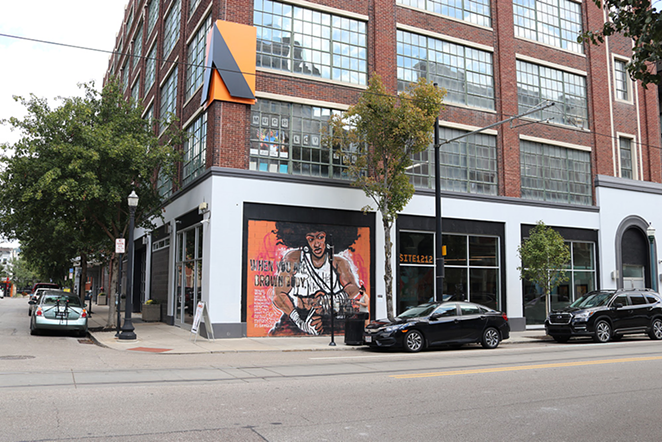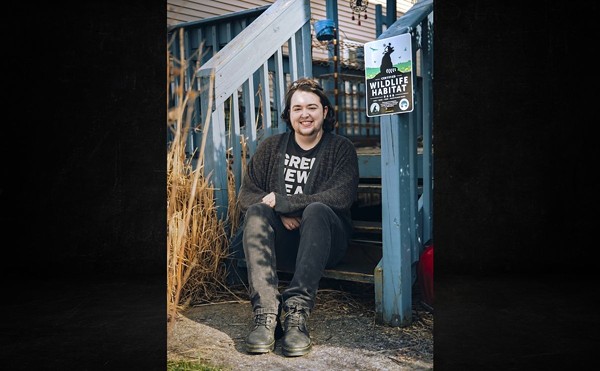The Art Academy of Cincinnati (AAC) has expanded into a neighboring space while simultaneously hoping to expand the school’s mission.
The recently opened SITE 1212 is the AAC’s “new center for community impact.”
Located at 1212 Jackson St. in the former BarrelHouse — a popular music venue and one of the city’s first wave of modern microbreweries — the spot remained vacant from the brewpub’s closure in 2010 until AAC began renovations to expand their campus in 2019. Alongside Elevar Design Group, AAC transformed the space into a community gathering place for artistic work and urban problem-solving.
SITE 1212 was unveiled with a “1212 House Party” on Aug. 27 and 28 on the block of Jackson Street in front of the AAC. Festivities included live music from local indie bands the Young Heirlooms and Wussy Duo; a fashion show by Lindsey Whittle; and OTR mural tours through ArtWorks. Artisans sold handmade work, apparel and crafts. Taste of Belgium, Banging Brothers and Hoff’s Pretzel Company sold signature culinary items.
According to AAC President and CEO Joe Girandola, SITE 1212 is the conclusion of yearslong conversations between the school’s faculty, staff, alumni and trustees.
“Congealing all those ideas into one is a very difficult task,” Girandola said in a presentation about the space. “I say, ‘Why can’t it just be a blank canvas for the most amazing work to be highlighted from our faculty, from our students, from our alumni? To bring people in through the doors to see what is possible when you enable this amazing college of art and design to expose itself to the community?”
In the same presentation, Greg Otis of Elevar Design Group and an AAC Trustee Board member, recalled mapping out the school’s future five years ago. He engaged the community to learn what they knew of the college.
“Many of them said, ‘Who? The art museum? What?’ That was disheartening — and a lot of pressure on us to figure that out,” he said. These conversations, Otis explained, revealed how relevance was key. They defined the vision for AAC’s future as bolstering students’ experience, engaging the community and transforming the former BarrelHouse space into whatever the school needed.
Fast-forward to 2021, on a hot summer day at the start of a new school year, the 1212 House Party offered a glimpse of that vision. More than that, perhaps, it reintroduced AAC to the Cincinnati creative class and the public at large. Attendees shopped original work made by AAC students and alumni, toured a gallery of works by Cincinnati painter and AAC alumnus Jim Effler and sipped micro-crafted vanilla stout created by the original BarrelHouse brewmasters Rick Debar and Brian Sprance.
Gathering Cincinnati creatives is just the start. To sum up the mission at its most basic, Girandola tells CityBeat that SITE 1212 is about making a difference in the region. He sees artists as uniquely positioned to use their talents to collaborate with organizations and imagine solutions beyond the studio to make a social impact.
“Artists not only have a vision aesthetically but could collaborate with community partners — like the Homeless Coalition of Cincinnati, Freestore Foodbank, many different programs in the city that are trying to make a difference,” says Girandola, who considers SITE 1212 a laboratory for such ideas. “Why not enable artists to be at the table when problems are being discussed?”
To illustrate the potential power of including artists in such conversations, Girandola describes the work of his mentor, artist Mel Chin. Chin’s experimental art project Revival Field aimed “to cleanse industrial contamination from affected soil with plants,” according to his website. The project involved re-employing plants at a specific site to act as “toxic sponges” to pull out heavy metals from the soil. Chin’s website explains the project “calls for collaboration between the artist, the academic and the environmentally-concerned community.”
“What creatives do at the table is say, ‘Throw out those solutions. Here’s something no one’s thought of,’” says Girandola.
Though AAC has a 152-year history, Girandola says the curriculum has evolved to enable students to engage in their environment through their artistic skills. How can they translate still-life painting into community activism? How does animation apply to social engagement? The creative processes at play inside the classroom are not only skill-based but solution-based.
One such example is a program called HATS (“Higher Art Time Saved”), a collaboration between AAC and the Ohio Justice & Policy Center. HATS was slated to begin before the start of the COVID-19 pandemic but was postponed until spring 2022. The program gives women who have been incarcerated the opportunity to learn digital literacy skills that ease their transition from prison to release to the workforce. Girandola says HATS provides tools that enable them to be storytellers of their own lives and communicate effectively their experiences when seeking employment.
“Enabling a core curriculum for individuals while they’re in prison to be able to exist as human beings when they’re released is the least we can do,” says Girandola. “There’s no better program than what we are enabled to do as storytellers ourselves, as creatives, than to collaborate with this kind of program.”
Last summer, AAC launched The Leaders Academy — a STEAM program that invites select area high school students to spend a week on campus and engage in workshops facilitated by local leaders. The overarching goal is to provide knowledge and inspiration for students — specifically from Black and Brown communities — to harness the powers of entrepreneurialism and creativity so that they can solve real-world problems with artistic thinking.
One of the speakers at AAC’s recent Leaders Academy was Kick Lee, executive director at Cincinnati Music Accelerator (CMA). The nonprofit organization educates and develops musicians toward an artistically-based, business-focused career. Their goal is to establish Cincinnati as a music city where artists thrive. AAC and CMA have partnered on numerous initiatives, and SITE 1212 promises to continue that relationship.
“Both entities are really focused on being more inclusive in the arts as a whole, not just music and fine arts,” Lee tells CityBeat. “Through this partnership, we’re working deeper and harder at being more inclusive in the arts.”
While AAC offers undergraduate degrees like design, illustration, painting and drawing, the school currently doesn’t offer musical education. Lee says they’re working together to introduce the CMA music business program into the curriculum, having received a $25,000 grant from Black Empowerment Works. He also envisions holding performance workshops, fundraisers and other community events at SITE 1212.
Alazandrea Townsend, a senior at AAC and president of the Black Student Union, sees opportunities for both artistic and social engagement.
“I envision seeing my work in the 1212 suite space, being admired along with my peers, family, friends, faculty and staff,” Townsend tells CityBeat.
She says the space can also “encourage our fellow people of color and allies to come together, display their art and discuss any injustice or discriminatory topics that have occurred while attending school or throughout their life.”
AAC sophomore Keith Wallick, who is vice president of the Black Student Union, echoes Townsend.
“I create art to heal, spread joy and create conversation on how to love yourself, others and the world around you,” he says. “With SITE 1212 as a space where the community and the Art Academy can weave a radiant relationship, I hope to at least touch one person. Healing is contagious, and like a Pothos plant, it can propagate and be shared with others.”
Learn more about SITE 1212 at artacademy.edu.








